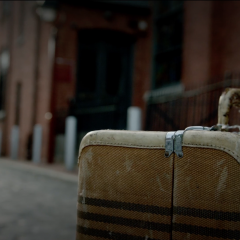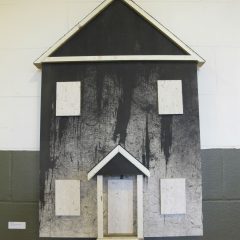Charleston is a city of contradictions, some of them superficial–like the old-fashioned paper fan next to the HDTV in our guest room. Some of the contradictions date from pre-Civil War and run disturbingly deep–like the independent tour guide who gave me his business card imprinted with a Confederate Flag.
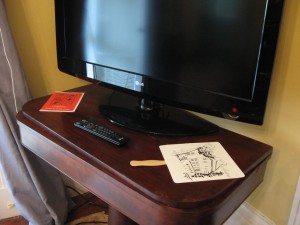
We were there last week for Murray and Dan’s book talks, staying in housing for visiting faculty at the College of Charleston. I loved sliding down the side of the very very tall four-poster bed,
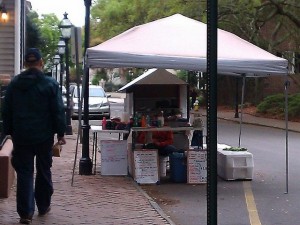
Right down the street from us was a small food cart featuring only hotdogs and sausages. It smelled great, but was pretty low key compared to the mega-foodtrucks that take over the curbsides at Temple and Penn.
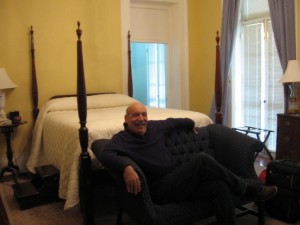
Charleston is a big town for gardens. The week we were there, Spring was springing and we looked at the early blooms on azaleas and roses and flowering trees.
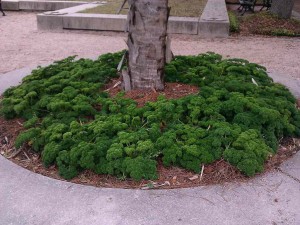
We wondered at the use of parsley as an ornamental, hard by the ornamental kales.
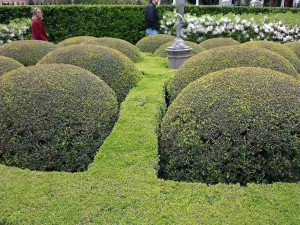
We were stunned by the obsessive topiary at the John Calhoun Mansion (named for the grandson of John C. Calhoun). Where we were staying, little putti fountains enhanced the gardens outside our piazzas (the term for the porches on nearly every building for catching breezes in the brutal summertime).
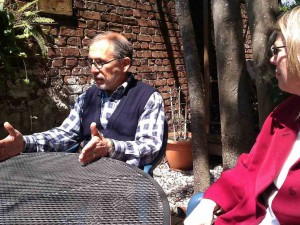
Among the gardens we visited were a pair of cemeteries, which people seem to use as back alleys to navigate the city. In one of them, outside a Unitarian church, the plants were encouraged to grow beyond the edges of the walkways and across the neighboring graves, creating a romantic landscape. Our walking-tour guide of the day, archivist Harlan Greene, then pointed out a nearby German cemetery, in which plants were restrained within the boundaries of the layout. Of course. This contrast of aesthetics is not surprising, but having our stereotypes confirmed this way did make us laugh. Greene worked at the Avery Research Center at the University of Charleston when Murray and Dan were researching their book. Now he’s head of Special Collections at the Addlestone Library at the College of Charleston.
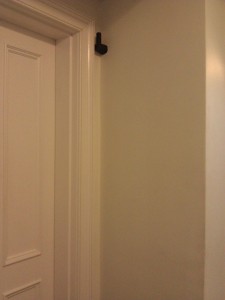
Greene, who invited Murray and Dan to speak at the College of Charleston library, took us into City Hall, in part to show us the remains of bars and gates in the basement of City Hall. They probably are the only remaining physical record of the imprisonment of convicted slave-revolt plotter Denmark Vesey and 34 supporters–all hanged. The bits of iron barely survived the renovation of the basement, and Greene, who fought tooth and nail to preserve them, was proud of his success. (Greene is on a number of civic boards, including one that had some say in the renovations).
During our stay we visited museums and houses, a plantation, and just wandered the streets of the historic city, which is on a peninsula that points into the bay toward Fort Sumter, where the first shots of the Civil War were fired. We were there a few days before the 150th anniversary of those shots.
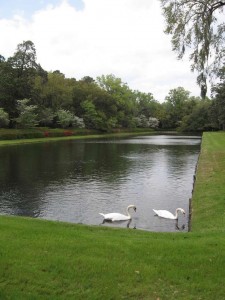
The gardens of the Middleton Place plantation, up a ways inland along the Ashley River, are spectacular, from the reflecting pool to the vast, visionary gardens overlooking a vista of the river. The gardens step down in an undulating, terraced lawn to reveal two classically balanced formal ponds, each shaped like a butterfly wing.
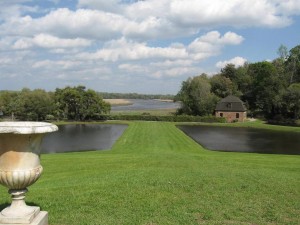
The butterfly ponds are not just ornamental. They are part of an agricultural water system to flood and drain the rice fields (I learned the fields had to be drained three times per harvest). The formal gardens and romantic wild areas were both incorporated into the plantation’s landscape. Besides a balanced pair of oblong beds called parterres, which were bursting with camellias, azaleas, and evergreens, near the house (or what’s left of it since Sherman’s troops burned it down), a nearby hillside glowed with 36,000 azaleas–a later, more romantic addition. The azaleas, just beginning to bloom, were also reflected in the creek water below the hillside. Wow.
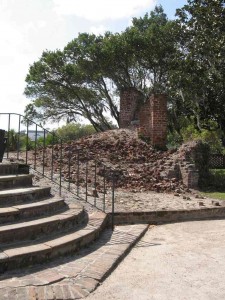
The lesson I learned at that plantation, which was one of 20 rice plantations that the Middleton family owned, is that people who owned rice plantations were filthy rich. They spent a lot of time traveling–to Europe for a few years, and to Rhode Island to escape the unbearable summers. They participated in state and national affairs. Their life style contrasted strongly with the lives of the people who made them rich–the slaves who took 10 years to build the gardens, and who farmed the rice, working through the unbearably hot and humid summers. Sherman’s army burned down the three houses of the plantation in 1865. We toured the one house that was rebuilt (it’s one of the flanker houses off of the main one). Our house-tour group, who came from hither and yon, not just the South, clucked in dismay at the loss of the buildings. This same group, and the tour guide himself, didn’t seem interested in celebrating that 100-plus slaves got their freedom.
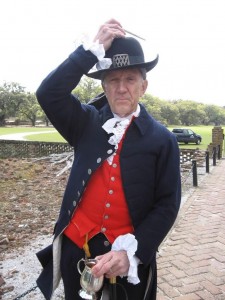
This, and all the Southern pride in their ancestors who fell in the war and their pride in the agricultural economy that concentrated wealth among a rare few at the expense of all others reminded me of the current state of affairs in the country. Today poor and middle class citizens fight taxes for the very rich–a policy that has concentrated obscene wealth in just a few hands. Back then, poor and middle class southerners fought for the right of their obscenely wealthy neighbors to hold slaves.
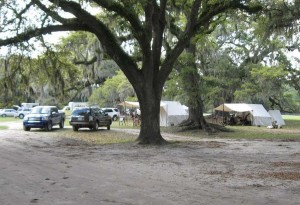
While we were at the plantation, we ran into some Revolutionary War re-enactors there for the weekend. Speaking of contrasts, I loved the tent encampment next to the SUVs!
Before we left Charleston, we visited the Old Slave Mart Museum, the site of the historic Ryan’s slave market–one of a number of slave auctions in the city. Among the highlights were recorded reenactments of slave narratives collected by the WPA in the 1930s. The stories told of the uncertainties each slave faced as he or she passed through the dehumanizing process of being assessed and bid on. Some of them were canny enough to scare off unsavory buyers, but whatever their fates, it was largely a matter of luck–and none of the luck can be described as really good as families got split, never to see parents, children, and siblings again. The museum, like the city itself, did a really great job of making the past come alive.


